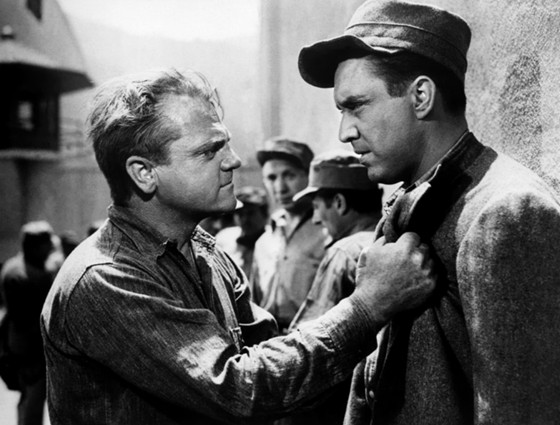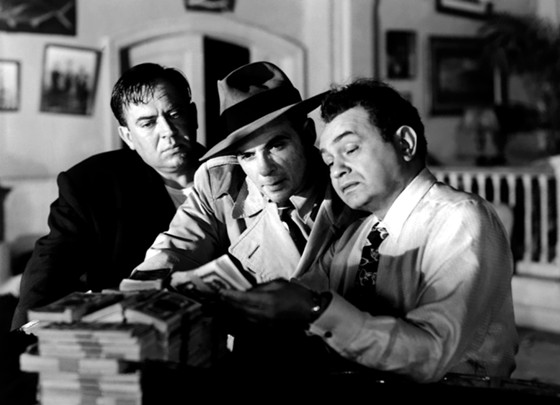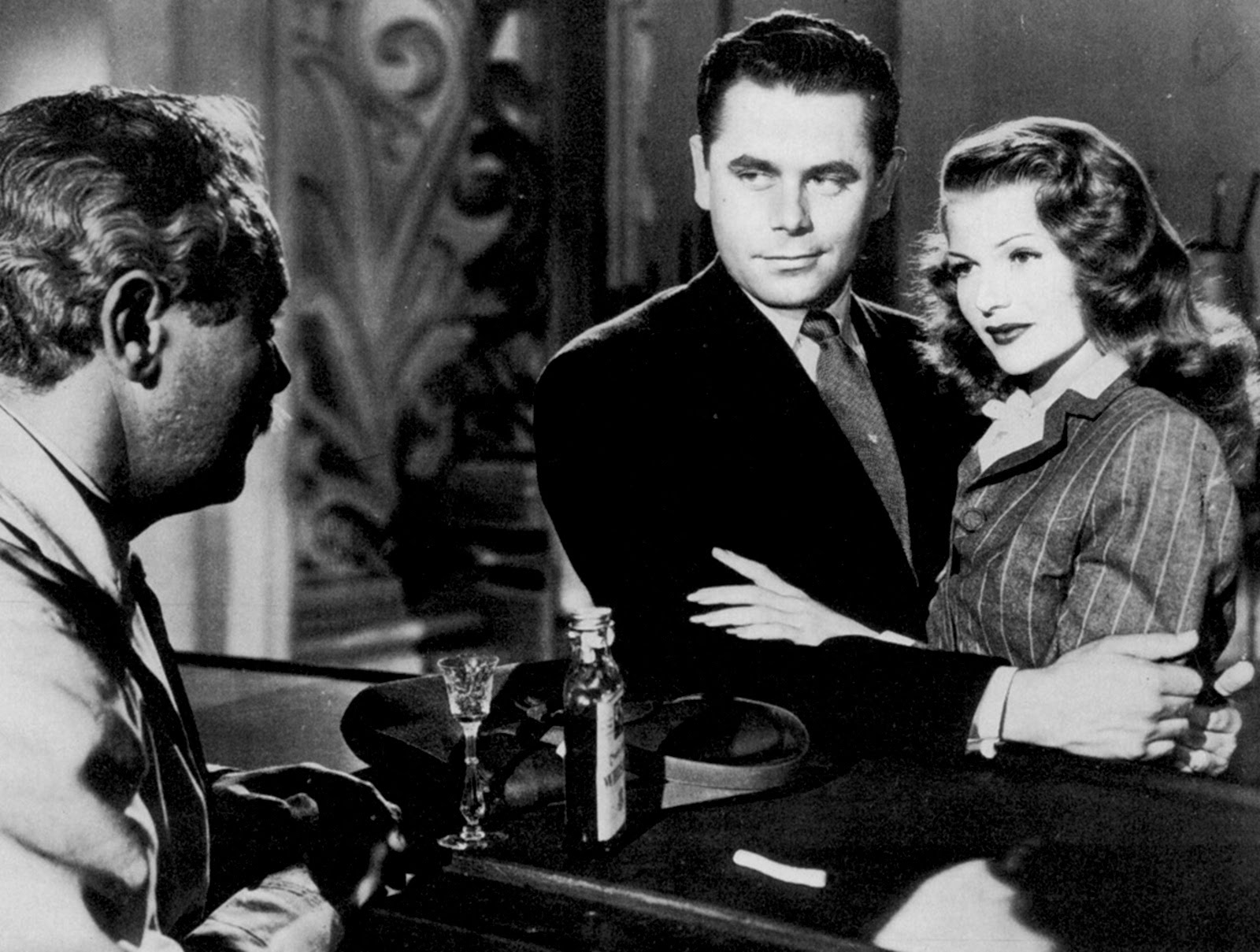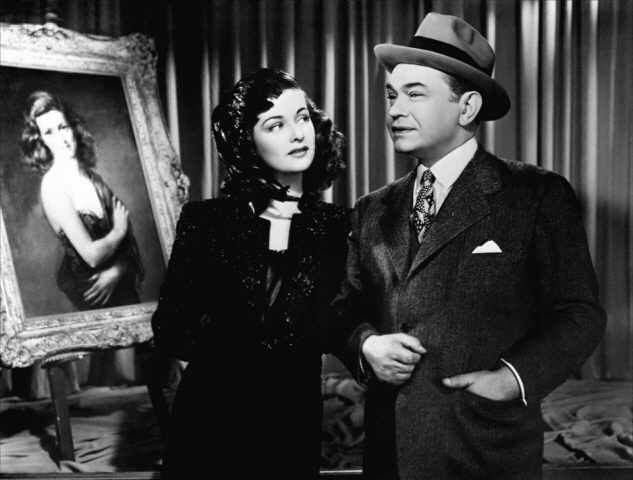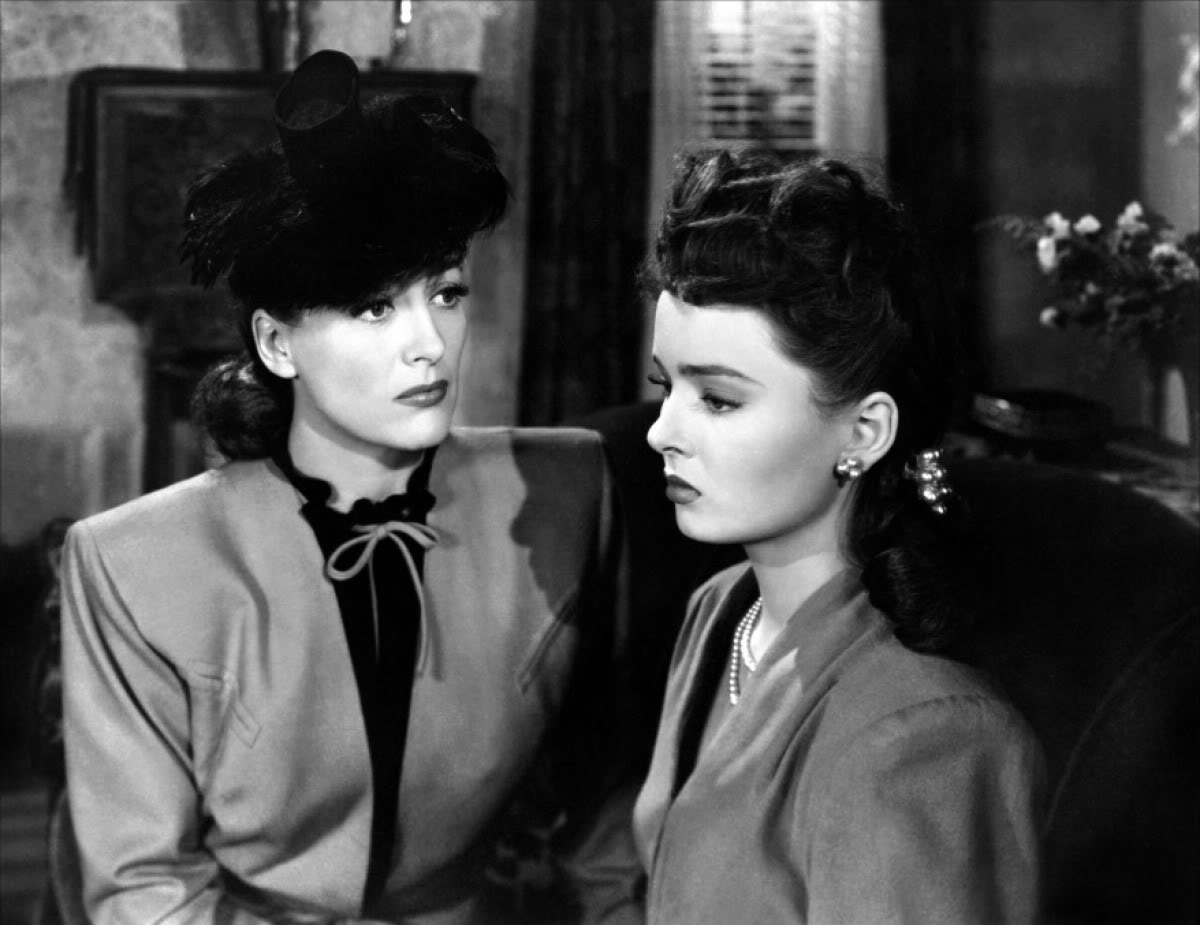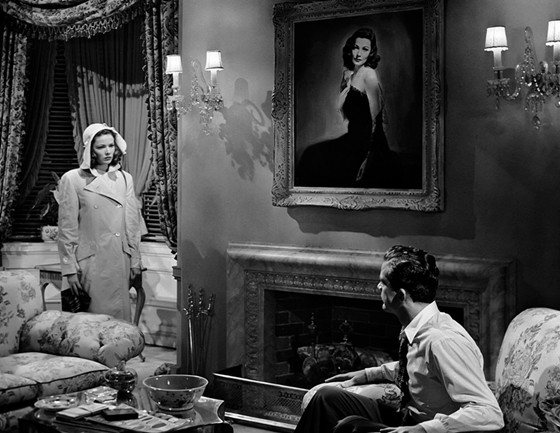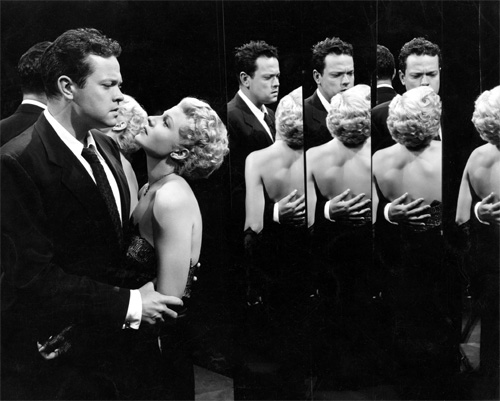What is Film Noir? It is a term coined in French, meaning literally ‘black film’ that is used to define a genre, or possibly just a subset of the genre of the thriller. Film scholar Alain Silver has asserted that film noir is not a genre but a ‘cycle’ of films that occurred during a certain historical period of time.
Film noir thrived predominantly in Hollywood crime films in the early post World War II years, as men were returning from the military to their lives at home, and it expresses the anxiety that many men felt about being displaced as workers, boyfriends, husbands and fathers during wartime.
This anxiety is expressed in film noir – particularly the early film noir of the 1940’s that this list will focus on – as a sense of disorientation, confusion and distrust, as well as a sense of entrapment in a nightmare world that has gone out of control. The protagonists of these film are men who are often in love with and yet betrayed by beautiful women and they often face the choice between a fair haired ‘good’ woman and a dark haired, sultry ‘femme fatale’ who is likely to lead them astray down the wrong path (which is the path that they take, for the most part). Most of these early film noir are told in flashback with voice over and are shot with many night scenes featuring high contrast lighting, dark shadows and odd camera angles.
This then is a list of the 15 essential films that one must be familiar with in order to understand the early, ‘classic’ period of film noir that thrived from 1940 to 1949.
15. White Heat (1949)
White Heat is part film noir, part gangster film, with James Cagney as criminal ringleader Cody Jarrett. Married to the deceitful Verna (Virginia Mayo) but totally devoted to his mother, “Ma” (Margaret Wycherly) Cody and his gang rob a mail train but the job goes awry. Cody confesses to a lesser crime in order to get a shorter prison stretch; in prison he is befriended by Hank Fallon (Edmund O’Brien) an undercover agent trying to find out who is laundering Cody’s money. On his release from prison, Hank comes along with Cody as he must deal with his right-hand man Ed Somers who is trying to take over his gang, and his wife.
White Heat has two memorable scenes, one in the prison dining hall when Cody freaks out after hearing the news that his mother has died and the second the film’s finale, a big shoot out at a chemical plant. Surrounded by police atop one of the chemical tankers, Cody goes insane screaming “Top of the world, Ma!” as he blows himself up. White Heat is not a prototypical noir film of the time, but more of a gritty gangster film with noir elements. Directed by Raoul Walsh, the film features memorable performances by Cagney and noir regular Edmund O’Brien.
14. Key Largo (1948)
Another veteran of 1930’s gangster films, Edward G. Robinson, was featured in Key Largo along with Humphrey Bogart, one of the definitive noir actors, and Lauren Bacall. Bogart is Frank McLoud, recent combat veteran who stops in at the Key Largo hotel of James Temple (Lionel Barrymore) and his daughter-in-law Nora (Bacall), widow of an army friend of Frank’s. Staying at the hotel is Johnny Rocco (Robinson), a gangster exiled to Cuba for the past few years, who is holed up with his gang waiting to make contact with some criminal associates.
Rocco holds the Temples and McCloud as virtual prisoners in the hotel after killing a police officer during a violent hurricane, at one point humiliating Frank as well as his alcoholic former girlfriend, Gaye Dawn (Clair Trevor). With the law closing in, Rocco forces Frank to pilot a boat to take Rocco and his gang back to Cuba. Frank ends up taking out Rocco’s hoods one by one until it is just Rocco and himself, then kills the gangster in a final, climactic shootout, before piloting the boat back to Key Largo and the Temples.
A meditation on heroes and heroism, Key Largo is a gritty film that, like many of director John Huston’s best works, shows people at their worst and best during times of extreme stress and difficult circumstances. Although Key Largo has a sense of optimism at the end that is unusual for a film noir, it has the bleak tone and problematic characters that are typical of the genre. This was the fourth and final film of Bogart and Bacall, including Dark Passage (1947), another outstanding film noir.
13. Gilda (1946)
The definitive film of one of the definitive actresses of the classic noir period, Gilda stars Glenn Ford as Johnny Farrell and Rita Hayworth as the title character. As in many film noir, Farrell narrates the story in voice over from the time he arrives in Argentina, a small time gamble and casino cheat, and eventually hooks up with casino owner Ballin Mundson (played by the creepy George McCready as one of noir’s best ever bad guys).
Johnny becomes Mundson’s right hand man, but their relationship is strained when Mundson returns from a trip with a beautiful young wife, Gilda, whom Farrell has known in the past and purports to despise. But when Mundson double crosses some Germans running a secret cartel, he fakes his own death and disappears. Johnny and Gilda end up marrying despite the fact that they appear to hate each other; at one point, Gilda performs a sexy strip tease to the song “Put the Blame on Mame, Boys” in order to infuriate Johnny, and it became one of the film’s iconic moments.
We won’t give up more of the plot, but suffice it to say that Gilda, with its sense of brooding hatred, distrust of beautiful woman and double crossing of friends and associates, has all of the elements of a classic film noir. Directed by Hollywood veteran Charles Vidor, Gilda was photographed by Polish born Rudolph Matte, who himself would go on to direct D.O.A., one of the 1950’s best film noir.
12. The Woman in the Window (1944)
Many characters in film noir based their actions on deeply seeded psychological motivations, and nowhere is this more evident than in The Woman in the Window, directed by German emigre Fritz Lang, who made a number of classic films in Germany (such as Metropolis and M) before fleeing Hitler. Edward G. Robinson plays a criminology professor, Richard Wanley who, after he sends his wife and children away for vacation, meets friends at a club for dinner. On entering the club, Wanley has seen a portrait of a beautiful woman, Alice Reed, in the window of a nearby building and after his dinner he happens to meet Reed on the street and goes back to her apartment.
Into Reed’s apartment bursts her rich and jealous lover, Claude Mazard and after a brief struggle with Wanley, Mazard is killed. Reed and Wanley bury the body in the country but leave a number of incriminating clues, some of which come to light when Wanley is called in to consult on the crime by his D.A. friend Frank Lalor (Raymond Massey). The situation becomes even worse for Wanley when Reed begins to be blackmailed by crooked ex-cop Heidt (Dan Duryea, a frequent noir bad buy and character actor). Can Wanley escape from the trap that his fascination with the beautiful Alice has ensnared him?
See The Woman in the Window and its twin brother Scarlet Street (released a year later, also directed by Lang, starring Robinson, Bennett and Duryea) to find out. With its emphasis on Freudian psychological explanations for criminal behavior, The Woman in the Window was a ground breaker and certainly is one of the most interesting films from the classic noir period.
11. Mildred Pierce (1945)
Warner Brothers, with its emphasis on crime and social problem films, was one of the earliest and most successful studios to make noir films. When Joan Crawford left MGM and came to Warners, this was her initial outing as star (Bette Davis famously turned down the part before her) and it was an enormous success. The film seems to function in two worlds, the melodramatic daytime world of Mildred’s successful restaurant chain that is filmed in low contrast ‘high-key’ lighting, and the noir nighttime world of Mildred’s outside life with daughter Veda (Ann Blyth) and her chiseling second husband, Monte Beragon (Zachary Scott) that is filmed in the shadowy, high contrast, chiaroscuro lighting style typical of film noir.
When hard working Mildred (Crawford) divorces her first husband Bert Pierce (Bruce Bennett), she is determined to make a success of herself for her daughter Veda, who seems to want all the best things in life. The restaurant that Mildred starts is a money maker and, with the help of business manager Wally Fay (Jack Carson) Mildred opens a chain of eateries and can give Veda all she wants, until into their life comes Beragon, a formerly wealthy playboy who married Mildred. Veda eventually despises the plebeian way her mother makes a living and seems to be in love with Monte, who – in the opening scene of the film – is shot to death at Mildred’s beachfront home.
Like many film noir, the entire movie is told in flashback until, at the end, the killer is revealed. A tour de force performance by Crawford brought her a well deserved Academy Award (while Bette fumed) for best actress, and her career was resurrected for over a decade at Warner’s, where she made such later films such as Humoresque, and in 1954 she made the camp western Johnny Guitar that some view as the only western film noir.
10. Laura (1944)
Of all the women of film noir, Gene Tierney was perhaps the most alluring, and the 1944 film Laura, directed by Otto Preminger, is a great vehicle for her talents. Like The Woman in the Window, Laura features a protagonist under the spell of a beautiful women in a portrait; in this case it is Police Detective Mark McPherson (Dana Andrews). The portrait is of Laura (Tierney), a beautiful advertising executive. McPherson is investigating her brutal murder, which includes suspects Waldo Lydecker (Clifton Webb), Laura’s mentor, her on again-off again fiancee Shelby Carpenter (Vincent Price) and Laura’s Aunt, Ann Treadwell (Judith Anderson), who appears to have an unusual interest in Shelby.
As McPherson investigates the crime and questions the suspects, he becomes more and more obsessed with Laura until Waldo accuses him of falling in love with the dead woman. One night in Laura’s apartment, McPherson drinks himself into a stupor while looking at Laura’s portrait only to fall asleep and wake up to…surprise! Well, you’ll have to see it yourself, but suffice it to say that Laura has as many twists and turns as most of the film noir of the period, and perhaps a few more.
As in many film noir, the beginning of the film is told in flashback, with voice over by Webb’s Waldo Lydecker in this case. Produced at Twentieth Century Fox and shot in beautiful black and white by Preminger, another German emigre and one of the masters of the genre, Laura was based on a novel by Vera Caspary and was transformed from what might have been a run of the mill detective film into a true classic.
9. The Lady from Shanghai (1948)
Orson Welles was given the chance to direct again after his falling out at RKO and he produced The Stranger (1946), a solid film noir that starred Edward G. Robinson and Loretta Young. When The Stranger was a box office success, Harry Cohn gave Welles a chance to direct his wife, Rita Hayworth, in The Lady from Shanghai, and Welles produced one of the most unique and interesting film noir, albeit one with an incredibly convoluted and complicated plot.
Welles is ‘Irish’ Mike O’Hara, a sailor who meets beautiful Elsa Bannister (Rita Hayworth) in New York and, attracted to her, agrees to sign on as a hand on the yacht that she is sailing around the world on with her husband, famed lawyer Arthur Bannister (Everett Sloane). In Acapulco, the group is joined by Arthur Grisby (Glenn Anders), Bannister’s law partner, who convinces Michael to go along with him in a plot to fake Grisby’s death when they get to San Francisco.
The plan seems to have worked except for the interference of a private investigator, Broome, who is killed at the Bannister home, and eventually Grisby ends up dead and Michael is accused of his murder. Bannister serves as his attorney but, suspecting Michael is in love with his wife, has decided to lose the case. Michael escapes from the courthouse and into San Francisco’s Chinatown where Elsa appears, ostensibly to help him in his escape. Michael, Elsa and Bannister end up in an amusement park ‘hall of mirrors’ for a final shootout and it became one of the most well known sequences in American film. Welles used images of shattering glass and distorted mirrors to reflect the tragic, destructive relationships between the three characters.
The Lady from Shanghai was inimitably Welles, but Harry Cohn hated Welles’ visual style and intricate plot, reshooting and recutting the film to an early box office grave. Still, The Lady from Shanghai has survived as a triumph of Welles rare vision, and is one of the most stylistic and unique film noir of all time. As with most of the films of this era, the story is told by Welles in flashback with a voice over. Welles dyed his wife’s red hair blonde for the film and her mysterious portrayal of Elsa has become one of the best known femme fatale of film noir.

